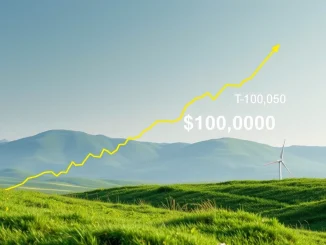
The cryptocurrency world has been buzzing about the recent surge in the Ethereum price. ETH has seen a significant upward move, catching the attention of investors and analysts alike. But what’s truly fueling this impressive climb? Is it a flood of new money, particularly from large institutions finally jumping into the market? Or is something else entirely at play?
What’s Really Driving the Ethereum Price Surge?
According to insights from Sui Chung, CEO of UK-based crypto index provider CF Benchmarks, as reported by CoinDesk, the primary force behind Ethereum’s (ETH) recent price rally isn’t fresh bullish bets or leveraged longs. Instead, it’s largely attributed to a technical market dynamic known as short covering.
Think about that for a moment. Despite ETH gaining nearly 90% since early April, the analysis suggests this massive move isn’t necessarily a sign of widespread new confidence or significant institutional demand entering the space right now. It’s more about existing market participants adjusting their positions.
Understanding Short Covering: The Key Mechanic?
So, what exactly is short covering? It’s a scenario where traders who had previously sold an asset short (betting its price would go down) are forced to buy it back to close their positions. When a shorted asset’s price starts rising unexpectedly or rapidly, these short sellers face increasing losses and are compelled to buy, which in turn adds buying pressure and further drives the price up. It creates a positive feedback loop, at least in the short term.
This mechanism can lead to sharp, dramatic price increases, sometimes even steeper than rallies driven purely by new buyers initiating long positions. It’s like squeezing toothpaste out of a tube – the pressure builds quickly.
Why Limited Institutional Demand Matters for the ETH Rally
The key takeaway from Chung’s analysis is the apparent *lack* of strong new institutional demand. How do we gauge this? Market indicators often provide clues. Two specific areas highlighted are:
- CME Futures Premiums: The premium (or discount) on futures contracts traded on the Chicago Mercantile Exchange (CME), a major venue for institutional crypto derivatives, can signal institutional sentiment. High premiums often suggest strong bullish sentiment and demand for leveraged long exposure from sophisticated players. However, recent data shows these premiums remaining relatively flat despite the price surge. This suggests institutions aren’t aggressively piling into new long positions via futures.
- U.S. Spot ETH ETF Inflows: While U.S. spot Bitcoin ETFs saw significant inflows after their launch, the recently approved U.S. spot Ethereum ETFs have seen limited inflows so far. This is another data point suggesting that the expected wave of fresh institutional capital directly into ETH hasn’t materialized in a significant way yet.
These two indicators, or lack thereof, point towards the rally being fueled more by existing market structure dynamics – like short covering and potentially closing out leveraged longs – rather than a fresh wave of buying pressure from new participants, especially institutions.
Reading the Signals: CME Futures and ETF Inflows in the Crypto Market
Understanding indicators like CME futures premiums and ETF flows is crucial for anyone navigating the crypto market. They provide insights beyond just looking at the spot price chart.
Let’s compare what these indicators might look like in different scenarios:
| Indicator | Sign of Strong New Demand (e.g., Institutional) | Sign of Short Covering / Repositioning |
|---|---|---|
| CME Futures Premiums | Significantly rising, high premiums | Remaining flat or showing modest increases |
| U.S. Spot ETH ETF Inflows | Consistent, large net inflows | Limited or minimal net inflows, potentially even outflows |
| Nature of Buying | New capital entering market, initiating long positions | Existing short positions being closed, potentially leveraged longs being de-risked |
The current situation, based on the analysis cited, aligns more with the signs of short covering and repositioning rather than robust new demand flooding the crypto market.
What Does This Mean for the Future Ethereum Price?
An ETH rally driven primarily by short covering can be powerful and rapid, but it raises questions about sustainability. Once the majority of vulnerable short positions are covered, this specific buying pressure subsides. For the rally to continue and be sustained over the longer term, new buying pressure from fresh capital, including increased institutional demand, would likely be needed.
Key Takeaways:
- The recent Ethereum price surge is largely attributed to short covering.
- Indicators like flat CME futures premiums and limited U.S. spot ETH ETF inflows suggest a lack of significant new institutional demand driving the rally.
- This rally appears to be more about existing market participants adjusting positions rather than new money entering the crypto market.
- While short covering can fuel sharp moves, sustainability may depend on whether new demand emerges.
Actionable Insight: Traders and investors should be aware of the technical nature of this rally. While the price action is positive, look for confirmation from indicators showing genuine new demand, particularly increased inflows into spot ETFs or rising futures premiums, to signal a potentially more sustainable upward trend for the Ethereum price.
Conclusion: A Technical Ascent for the ETH Rally
In summary, the recent impressive ETH rally seems to be a technical move driven by the unwinding of short positions. While this has provided significant upward momentum for the Ethereum price, the analysis points away from it being fueled by a major influx of new institutional demand at this time. Understanding this distinction is vital for assessing the rally’s potential longevity and the overall health of the current move in the crypto market. Future price action will likely depend on whether this technical squeeze is followed by a fundamental wave of new buying interest.



